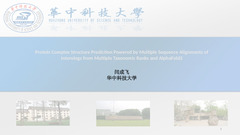Protein Complex Structure Prediction Powered by Multiple Sequence Alignments of Interologs from Multiple Taxonomic Ranks and AlphaFold2
编号:43
稿件编号:5 访问权限:仅限参会人
更新:2022-07-06 12:46:51
浏览:1259次
口头报告

报告开始:2022年07月24日 17:35 (Asia/Shanghai)
报告时间:15min
所在会议:[S4] 分会场4 » [S4-2] 结构生物信息与药物分子设计
摘要
Recently, AlphaFold2 achieved unprecedented breakthrough in monomeric protein structure prediction, which is also expected to be able to predict protein complex structures as long as a multiple sequence alignment (MSA) of the interologs of the target protein-protein interaction (PPI) can be provided. However, preparing the MSA of protein-protein interologs is a non-trivial task due to the existence of paralogs. In this study, a simplified phylogeny-based approach was applied to generate the MSA of interologs, which was then used as the input to AlphaFold2(Jumper et al., 2021) for protein complex structure prediction. Extensively benchmarked this protocol on non-redundant PPI dataset including 107 bacterial PPIs and 442 eukaryotic PPIs, we show complex structures of 79.5% of the bacterial PPIs and 49.8% of the eukaryotic PPIs can be successfully predicted, which yielded significantly better performance than the application of MSA of interologs prepared by two existing approaches. Considering PPIs may not be conserved in species with long evolutionary distances, we further restricted interologs in the MSA to different taxonomic ranks(Federhen, 2012) of the species of the target PPI in protein complex structure prediction. We found the success rates can be increased to 87.9% for the bacterial PPIs and 56.3% for the eukaryotic PPIs if interologs in the MSA are restricted to a specific taxonomic rank of the species of each target PPI. Finally, we show the optimal taxonomic ranks for protein complex structure prediction can be selected with the application of the predicted TM-scores of the output models.
关键字
protein-protein interaction prediction;interologs;taxonomic ranks;complex structure prediction;AlphaFold2
报告人
闫成飞
副教授 华中科技大学闫成飞,华中科技大学物理学院副教授,2011年本科毕业于武汉大学物理学院,2016年在密苏里大学获得物理学博士学位,随后在耶鲁大学生物物理与生物化学系完成博士后训练,并于2019年6月份加入华中科技大学物理学院任教。闫成飞博士的主要研究领域为计算生物物理与生物信息,专注于开发基于数据挖掘的生物大分子相互作用复合物结构预测方法,在Structure, Briefings in Bioinformatics, JCIM, Science, Nature Methods 等重要杂志上发表论文20余篇。
发表评论